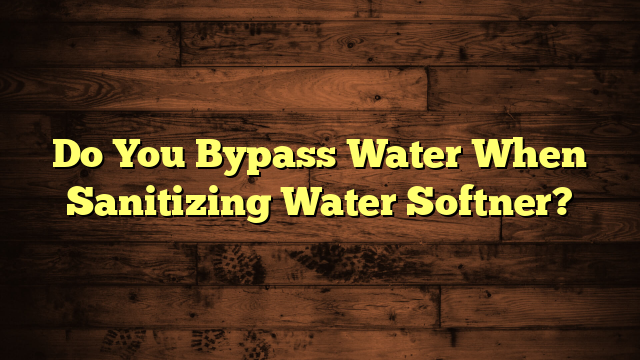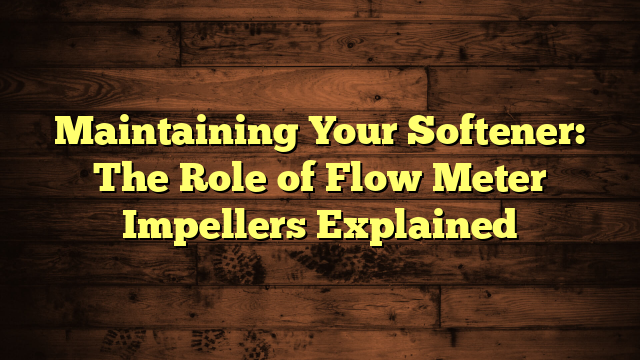Do You Bypass Water When Sanitizing Water Softner?
When it comes to sanitizing your water softener, you might wonder if you should bypass the water supply. Bypassing is essential; it prevents untreated water from mixing with your main supply while you apply sanitizing solutions. If you skip this step, you risk contaminating the very water you rely on. But how do you know when to engage that bypass valve, and what are the potential pitfalls of not doing it? Understanding these key aspects could save you from costly mistakes in your water treatment process.
Key Takeaways
- Yes, bypassing water is essential during sanitization to prevent harmful agents from contaminating the main water supply.
- Switch the system to bypass mode before adding sanitizing solutions to ensure proper sanitation flow.
- Bypassing allows for accurate water quality testing without the influence of the water softener.
- It helps maintain plumbing integrity during sanitization and prevents service interruptions.
- Always follow manufacturer guidelines while bypassing and sanitizing for effective results.
Importance of Water Softener Sanitization
When you think about maintaining your water softener, sanitization plays an essential role in ensuring its efficiency and longevity. Regularly sanitizing your system helps eliminate bacteria, mold, and other contaminants that can compromise water quality.
When you skip this crucial step, you risk introducing impurities into your home's water supply, which can lead to health issues and unpleasant tastes or odors.
Sanitization also enhances system efficiency. A clean water softener operates more effectively, ensuring that it can soften water without interruption.
By keeping your system free from buildup and contaminants, you're allowing it to work at its best, prolonging its lifespan and reducing the need for costly repairs or replacements.
You might be surprised at how easy it's to maintain your water softener. Simple steps like using a sanitizing solution and following the manufacturer's guidelines can make a world of difference.
Plus, by prioritizing sanitization, you'll enjoy the benefits of improved water quality throughout your home.
Understanding the Bypass Valve
The bypass valve is an essential component of your water softener, allowing you to redirect water flow during sanitization.
Understanding how it operates will help you know when and why to use it effectively.
Knowing the purpose of the bypass valve can make your sanitization process smoother and more efficient.
Purpose of Bypass Valve
A bypass valve plays an essential role in the operation of a water softener, allowing you to redirect water flow when needed. Understanding the bypass valve functions and types is vital for effective water treatment.
When you need to bypass the water softener, you can prevent untreated water from going through the system, which can be particularly useful during maintenance or sanitization.
Here are some key purposes of a bypass valve:
- Maintenance Access: It allows for easy servicing of the water softener without interrupting the water supply.
- Sanitization: You can sanitize your system without risking contamination of your main water supply.
- Water Quality Control: It lets you temporarily switch to untreated water for specific tasks, like watering plants that don't require softened water.
- System Protection: It helps protect your plumbing from potential issues caused by a malfunctioning softener.
- Flexibility: Different bypass valve types offer various methods to control water flow, giving you options based on your needs.
Bypass Valve Operation
Understanding your water softener's bypass valve operation is vital for effective maintenance and control. The bypass valve is a significant component that allows you to divert water away from the softener during maintenance tasks, like sanitizing or repairs.
Familiarizing yourself with the different bypass valve types—manual and automatic—can help you choose the right one for your needs. Manual valves require you to physically turn a lever, while automatic valves engage or disengage based on water flow or system pressure.
Regardless of the type you have, regular valve maintenance is important. This involves checking for leaks, guaranteeing smooth operation, and cleaning any debris that may interfere with the valve's function.
Using the bypass valve not only protects your softener but also guarantees that your home still has access to untreated water when necessary.
Always refer to your manufacturer's guidelines to understand specific maintenance tasks for your valve type. By keeping your bypass valve in prime condition, you can prolong the life of your water softener and maintain peak performance.
When to Bypass
Knowing when to bypass your water softener is vital for maintaining its efficiency and protecting your plumbing.
The bypass procedure is significant during specific situations to guarantee your system operates smoothly. Here are some scenarios when you should consider bypassing:
- During Maintenance: When you're performing routine softener maintenance, it's best to bypass the unit to prevent any interruptions in service.
- Water Quality Checks: If you're testing your water quality, bypassing helps you get an accurate reading without the softener's influence.
- System Malfunctions: When you notice any issues with your softener, bypassing can help you continue using water while you troubleshoot.
- Sanitizing the Softener: Always bypass the system when you're sanitizing it to avoid contaminating your water supply with cleaning agents.
- Hoses and Filters Replacement: Bypassing is necessary when replacing hoses or filters to prevent water from flowing through the softener.
When to Bypass Water
Knowing when to bypass water in your water softener is essential for effective sanitization.
You'll want to bypass water during the cleaning process to prevent contaminants from flowing into your home's plumbing.
Let's explore the reasons for bypassing water and the steps you need to follow to do it correctly.
Reasons for Bypassing Water
There are several key reasons you might need to bypass water when sanitizing your water softener. Understanding these reasons can help you maintain peak water quality and guarantee your system runs effectively.
Consider the following situations where bypass methods are essential:
- Preventing Contaminant Exposure: If you're using harsh chemicals during sanitization, bypassing guarantees these don't enter your home's water supply.
- Protecting Appliances: Bypassing can prevent damage to appliances that rely on softened water, as some sanitizing agents can be harmful.
- Maintaining Water Quality: If your water source has recently changed, bypassing allows you to assess the new quality before committing to full system use.
- Routine Maintenance Checks: Sometimes, you may want to sanitize your system without impacting the water supply for daily use.
- System Malfunctions: If your water softener is experiencing issues, bypassing can help isolate the problem and allow for troubleshooting.
Bypass methods are essential tools in your maintenance arsenal, guaranteeing that your water quality remains high while you keep your system in top shape.
Process of Bypassing Water
When you need to bypass water during the sanitization of your water softener, timing is essential. Knowing when to use bypass techniques can save you a lot of hassle.
Typically, you should bypass water when you're performing maintenance or cleaning your system, especially if you're using chemicals that could harm your plumbing.
To initiate the bypass, locate the bypass valve, usually found near the water softener. When you turn this valve, it redirects the water flow, allowing it to bypass the softener entirely.
Be certain to check the manufacturer's instructions for your specific model, as valve designs can vary.
After you've set the bypass, monitor the system to verify everything's functioning as expected. You don't want any unexpected leaks or issues.
Once the sanitization process is complete, remember to switch the valve back to its original position to restore normal water flow.
Steps for Proper Sanitization
Sanitizing your water softener is essential for maintaining clean, safe water in your home.
Without proper sanitization techniques, your water quality could suffer, leading to unpleasant tastes and potential health risks.
Follow these simple steps to guarantee your water softener is effectively sanitized:
- Bypass the system: Switch your water softener to bypass mode to avoid contaminating your water supply during the process.
- Drain the tank: Empty the resin tank to eliminate any accumulated debris or contaminants.
- Prepare the sanitizer: Mix a solution of unscented household bleach and water, following the manufacturer's guidelines for dilution.
- Add the solution: Pour the sanitizing solution into the brine tank, allowing it to flow through the system.
- Flush the system: After the recommended contact time, flush the system by running water through the taps until the bleach smell dissipates.
Benefits of Bypassing Water
Bypassing water during the sanitization process offers significant benefits that can enhance your water quality and protect your household plumbing. When you bypass the water, you prevent any harmful sanitizing agents from entering your home's water supply. This guarantees that the water you and your family consume remains clean and safe, free from any unwanted chemicals or residues that could compromise your health.
Additionally, bypassing water helps in maintaining the longevity of your plumbing system. When you avoid exposing your pipes and fixtures to these harsh chemicals, you reduce the risk of corrosion and other damage, which can lead to costly repairs down the line. By prioritizing both water quality and plumbing maintenance, you're making a proactive choice for your home.
Moreover, this practice allows your water softener to work more effectively, as it can focus on eliminating hardness minerals without interference from sanitizers. You'll notice an improvement in the feel and taste of your water, enhancing your daily life.
Common Mistakes to Avoid
One common mistake homeowners make is forgetting to read the manufacturer's instructions before bypassing water during the sanitization process. Ignoring these guidelines can lead to improper sanitization and even damage to your water softener.
Moreover, there are several other pitfalls to watch out for:
- Assuming all sanitization techniques are the same: Different systems require different methods.
- Not checking the bypass valve: Verify it's in the correct position before starting.
- Using the wrong sanitizer: Some chemicals can harm your unit.
- Overlooking the pre-sanitization checks: Always inspect your softener for leaks or clogs.
- Neglecting to flush the system after sanitizing: Failing to do so can leave residue that affects water quality.
Understanding these common misconceptions and avoiding these mistakes will help you guarantee effective sanitization.
By taking the time to follow the instructions and check your system, you'll maintain peak performance and extend the life of your water softener.
Signs Your Softener Needs Sanitizing
Over time, your water softener can show clear signs that it needs sanitizing. If you've noticed a sudden change in water quality—like a weird taste, foul smell, or cloudy appearance—these could be red flags.
Furthermore, if you see scale buildup on your faucets or around the softener itself, it's time to pay attention. Regular softener care is essential, and neglecting sanitization can lead to more significant issues.
Another sign is the presence of iron staining in your sinks or tubs. If your water softener isn't effectively removing minerals, it may need a thorough cleaning.
Pay attention to your system's performance; if it takes longer to regenerate or you encounter frequent error codes, these are indications that sanitization is overdue.
Finally, if your softener hasn't been sanitized in over a year, consider this a gentle nudge to act. Following proper sanitization tips can help you maintain peak performance and extend the life of your system.
Staying vigilant about these signs will keep your water softener running smoothly, ensuring you enjoy clean, soft water.
Maintaining Your Water Softener
Regular maintenance is key to keeping your water softener functioning effectively.
By following a few essential steps, you can guarantee peak water quality and proper salt usage. Here's what you need to do:
- Check salt levels regularly: Confirm your brine tank has enough salt to prevent system malfunctions.
- Clean the resin tank: Periodically clean the resin beads to maintain efficiency and prolong their lifespan.
- Inspect for leaks: Look for any signs of leaks in your system, as they can affect performance and water quality.
- Test your water: Conduct regular water tests to monitor hardness levels, ensuring your softener works as intended.
- Schedule professional maintenance: Consider having a professional inspect your softener annually to catch any issues early.
Frequently Asked Questions
Can I Use Softened Water for Drinking During Sanitization?
You shouldn't use softened water for drinking during sanitization. Softened water safety can be compromised, impacting drinking water quality. It's best to use untreated water until the sanitization process is complete to guarantee safety.
How Often Should I Sanitize My Water Softener?
You should sanitize your water softener every six months as part of your maintenance schedule. This sanitizing frequency helps guarantee peak performance and water quality, keeping your system running efficiently and effectively for your household needs.
What Products Are Safe for Sanitizing Water Softeners?
When you think of safe cleaning solutions, consider unscented bleach or vinegar as your trusted allies. They'll help maintain your system's health. Regular sanitization frequency keeps everything flowing smoothly, ensuring pure water for your home.
Will Bypassing Affect Water Pressure in My Home?
Bypassing your water softener can affect water pressure in your home. You might notice reduced pressure temporarily, as the system adjusts. Make certain you monitor the situation to maintain consistent water flow throughout your plumbing.
Can I Sanitize My Water Softener Myself?
Did you know that 80% of homes have hard water? You can definitely sanitize your water softener yourself using effective DIY sanitization techniques. Regular water softener maintenance guarantees your system runs efficiently and lasts longer.
Conclusion
In summary, bypassing water during the sanitization of your water softener is essential for maintaining clean, safe water. Imagine a pristine oasis, free from contaminants, flowing from your taps after a thorough sanitization process. By following the steps outlined, you not only protect your water supply but also extend the life of your softener. So, take the time to sanitize properly—your health and home will thank you with every revitalizing glass of water you enjoy.







